- 408-924-7560
- mineta-institute@sjsu.edu
- Donate
Past Webinars
MTI organizes or participates in several transportation-related webinars each year. You can find leading transportation experts at all of these webinars, making them an excellent resource for professional and research insights.
| Dates | Events |
|---|---|
June 26, 2020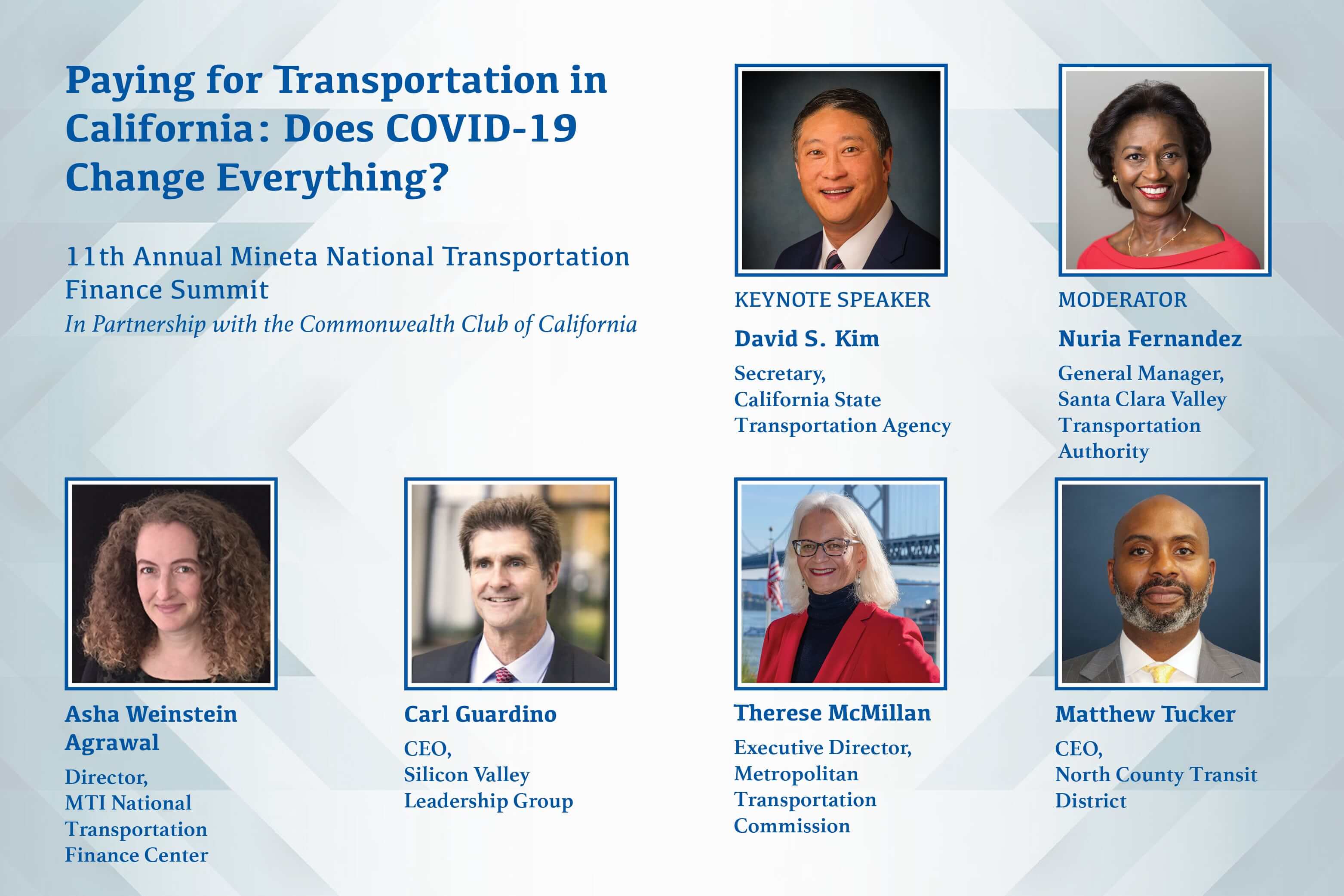 |
11th Annual Mineta National Transportation Policy Summit presents 'Paying for Transportation in California: Does COVID-19 Change Everything?' The COVID-19 pandemic threatens every aspect of transportation funding in California. State revenues from federal, state, regional, and local taxes and fees are all at risk. Since California’s shelter-in-place order went into effect in March, the state has already faced plummeting revenues from gasoline taxes, tolls, transit fares, and sales taxes. These revenue sources will most likely continue to be severely threatened in the coming months and possibly even years. Panelists discussed the opportunities for every level of government to help recover transportation revenues in our uncertain future. Can we rely on our traditional mix of revenue sources? Will the COVID-19 crisis stimulate innovation in transportation finance? These and other revenue options were discussed at the 11th Annual Norman Y. Mineta National Transportation Policy Summit. View Recording.View e-program. |
June 4, 2020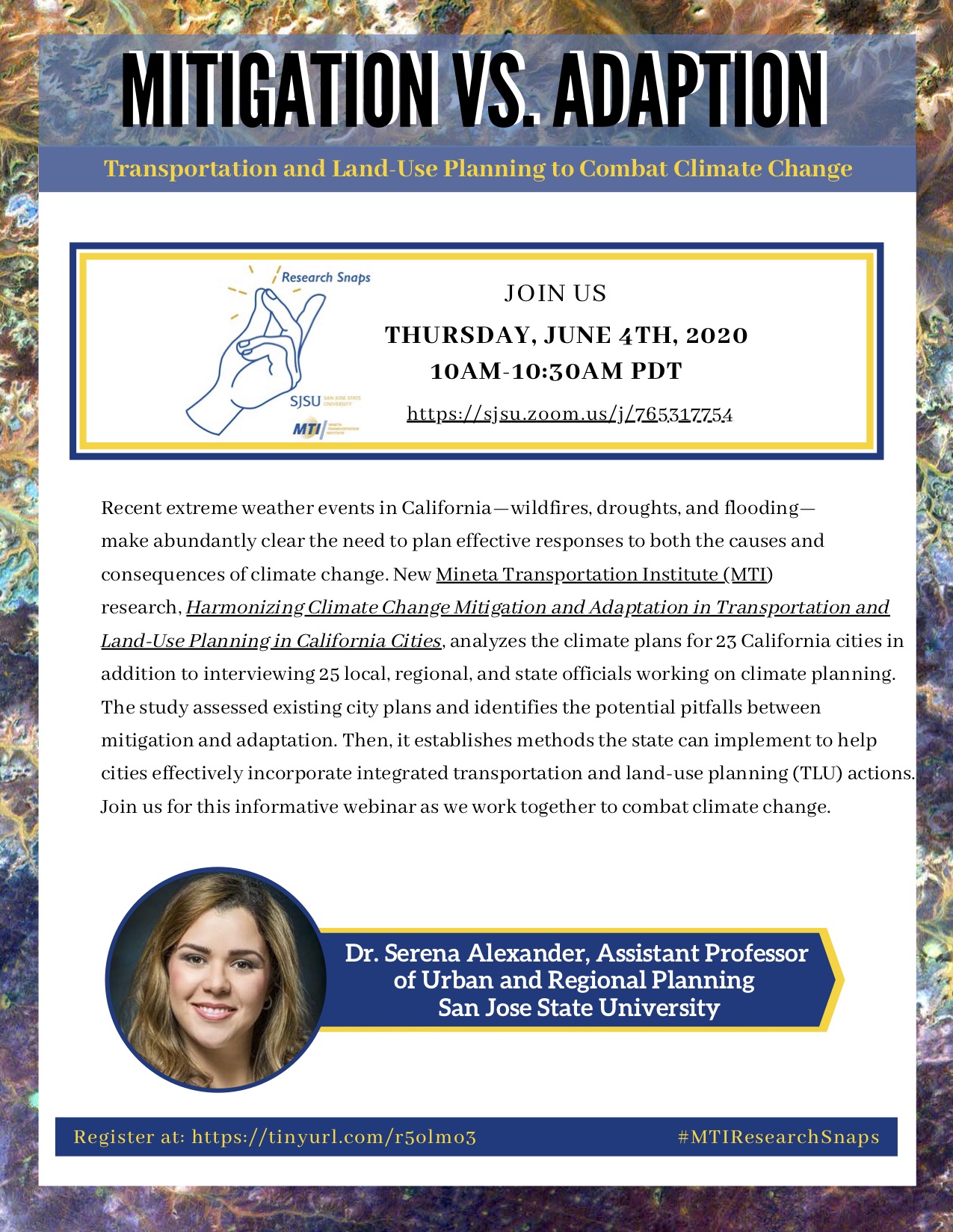 |
MTI Research Snaps Webinar: "Mitigation v. Adaptation, Transportation and Land-Use Planning to Combat Climate Change" Recent extreme weather events in California—wildfires, droughts, and flooding—make abundantly clear the need to plan effective responses to both the causes and consequences of climate change. New Mineta Transportation Institute (MTI) research, Harmonizing Climate Change Mitigation and Adaptation in Transportation and Land-Use Planning in California Cities, analyzed the climate plans for 23 California cities in addition to interviewing 25 local, regional, and state officials working on climate planning. Identified transportation and land-use (TLU) strategies that both mitigate greenhouse gas emissions and successfully prepare communities to be less severely impacted by climate change remains a challenge. The study assessed existing city plans and identified the potential pitfalls between mitigation and adaptation. Then, it establishes methods the state can implement to help cities effectively incorporate integrated TLU actions. View Recording.View Slides. |
May 21, 2020 |
2020 Garrett Morgan Sustainable Transportation Competition Much like Garrett Augstus Morgan, who, despite his humble beginnings as the son of slaves, recognized the importance of education, ideation, and entrepreneurship, we too are living in a time of great innovation. Most recently in light of the COVID-19 global pandemic, we’ve seen businesses adapt to ensure the safety of their employees and communities. Most significantly we’ve seen individuals and whole communities rally behind essential workers like nurses, service industry workers, and transit workers to ensure that they can continue to provide those critical services and keep all of us moving. And that is what we do in transportation: keep things moving. Regardless of this pandemic our industry is always teeming with new ideas focused on sustainability, traffic reduction, active transit, and others. And that’s where this competition comes into play by highlighting the significant creativity and innovation of these incredible students who put together projects despite the challenges associated with their schools closing as a result of COVID-19. Congratulations to the winners:
|
May 14, 2020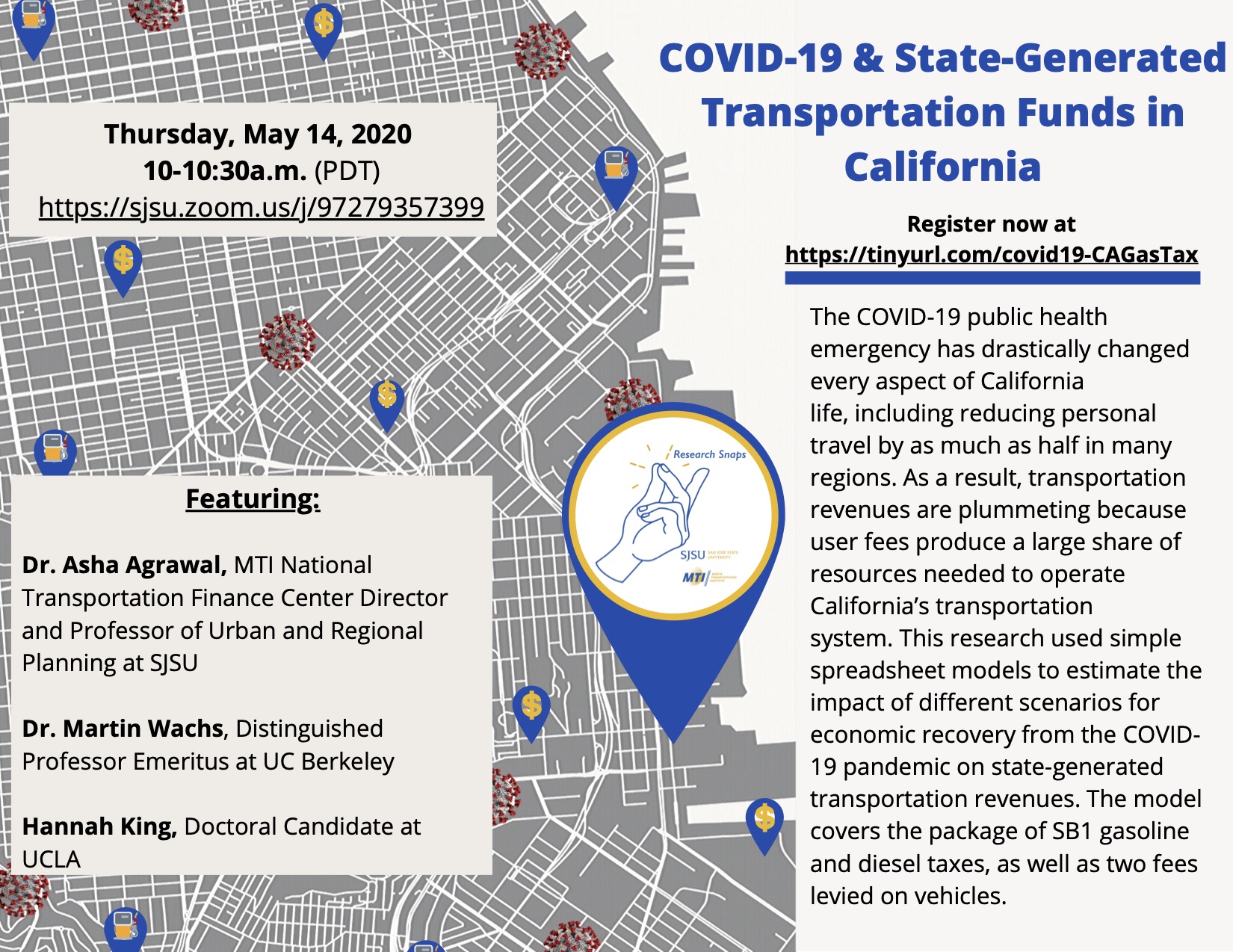 |
MTI Research Snaps Webinar: "COVID-19 & State-Generated Transportation Funds in California" The COVID-19 public health emergency drastically changed every aspect of California life, including reducing personal travel by as much as half in many regions. As a result, transportation revenues plummeted because user fees produce a large share of resources needed to operate California’s transportation system. This research used simple spreadsheet models to estimate the impact of different scenarios for economic recovery from the COVID- 19 pandemic on state-generated transportation revenues. The model covers the package of SB1 gasoline and diesel taxes, as well as two fees levied on vehicles. Panelist(s): Drs. Martin "Marty" Wachs and Asha Weinstein Agrawal with Ms. Hannah King View Recording.View Slides. |
April 9, 2020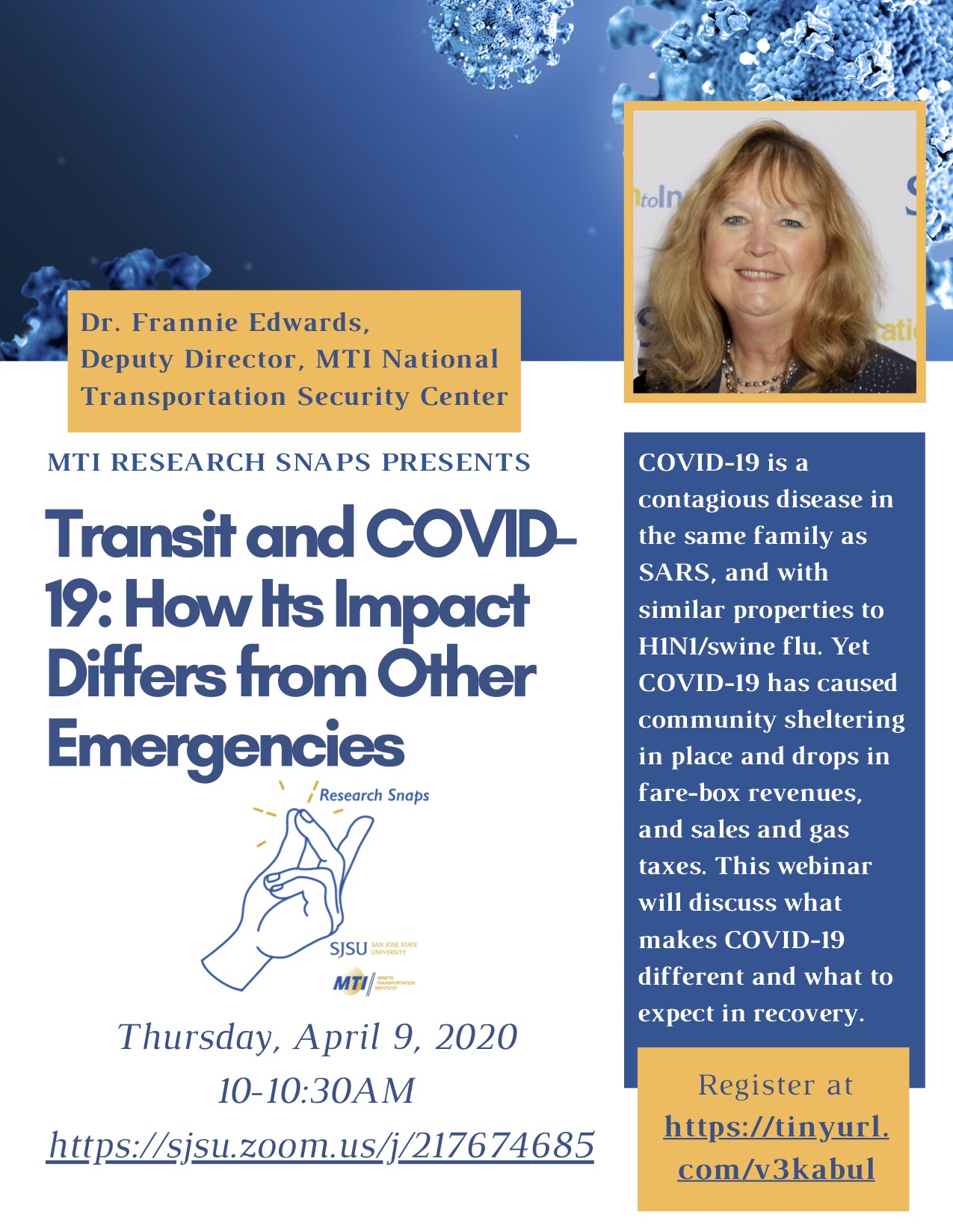 |
MTI Research Snaps Webinar: "Transit and COVID-19: How its impact differs from other emergencies" - Online COVID-19 is a contagious disease in the same family as SARS, and with similar properties to H1N1/swine flu. Yet COVID-19 caused community sheltering in place and drops in farebox revenues, and sales and gas taxes. The webinar has discussed what makes COVID-19 different and what to expect in recovery. View Recording.Additional Q&A |
March 19, 2020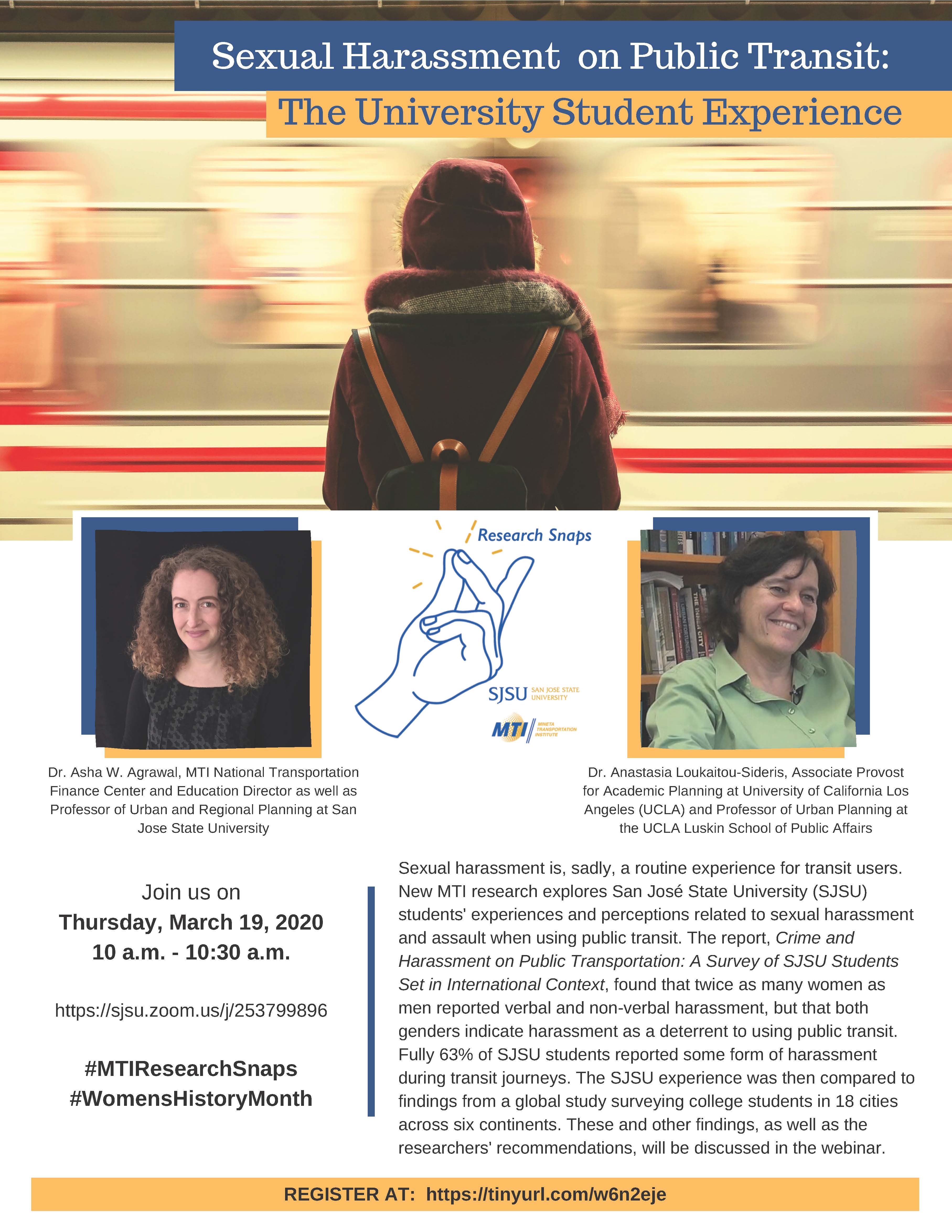 |
MTI Research Snaps Webinar: "Sexual Harassment on Public Transit: The University Student Experience" - Online Sexual harassment is, sadly, a routine experience for transit users. New MTI research explores San Jose State University (SJSU) students' experiences and perceptions related to sexual harassment and assault when using public transit. The report, Crime and Harassment on Public Transportation: A Survey of SJSU Students Set in International Context, found that twice as many women as men reported verbal and non-verbal harassment, but that both genders indicate harassment as a deterrent to using public transit. Fully 63% of SJSU students reported some form of harassment during transit journeys. The SJSU experience was then compared to findings from a global study surveying college students in 18 cities across six continents. These and other findings, as well as the researchers' recommendations,were discussed in the webinar. View Recording.View Slides. |
February 25, 2020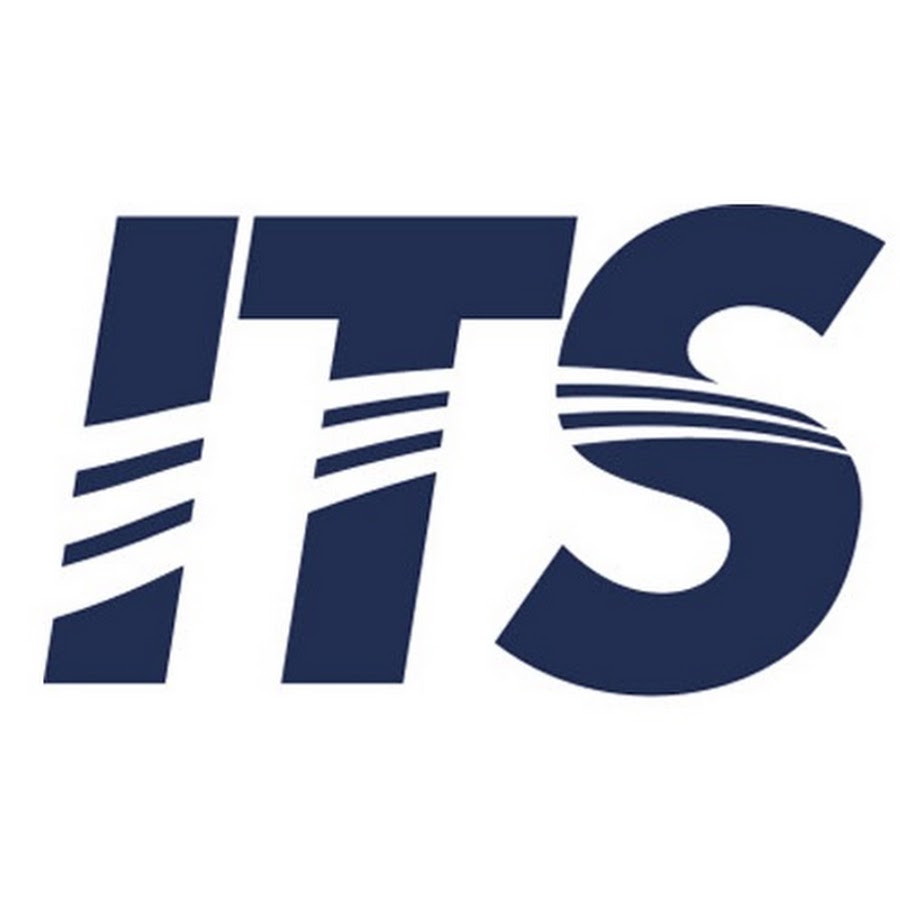 |
Overview of Two New and Growing California Housing Datasets - Online The purpose of this webinar is to introduce university researchers to two new and growing datasets at the Department of Housing and Community Development (HCD). The two datasets that will be covered on the webinar are described below: • Housing Element Annual Progress Report (APR): Includes information about the entire pipeline of development in each locality (i.e., development applications, approved entitlements, building permits issued and certificates of occupancy). This dataset also includes project identifiers (e.g., APNs, address), projected household income levels that will be served, and number of units in the developments. The presenter will review the new APR form (attached to this email). For more information about the Housing Element APR, please visit the Regional Housing Needs Allocation and Housing Elements webpage and click on the “Annual Progress Reports” located in the middle of the page. • Housing Element Site Inventory: The HCD is working on a more structured format to collect information from cities and counties. This format will allow cities and counties to consistently report location and projected density of parcels that are included in their Housing Element to accommodate their share of the Regional housing needs allocation. View Recording. |
January 30, 2020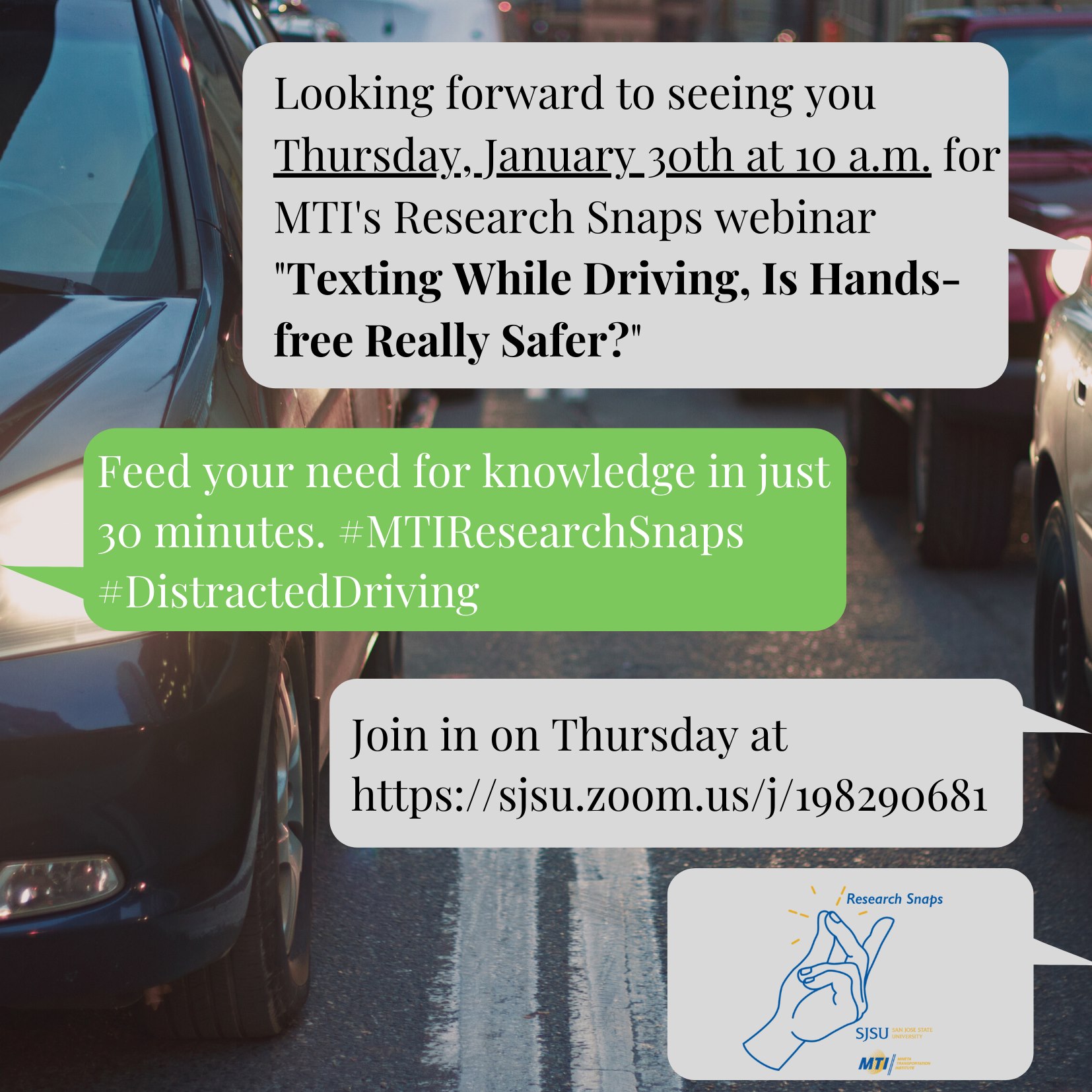 |
MTI Research Snaps Webinar: "Texting While Driving, Is Hands-free Really Safer" Hands-free texting is a popular way around a hefty fine in 48 states and often viewed as safe behind the wheel. However, MTI research found that while participants perceived an increased level of safety while using hands-free interfaces, response times and drift did not significantly differ from those manually texting. In conversation with Dr. Francesca Favaro, the webinar discussed how this seemingly convenient solution to texting and driving bans might do little to limit distracted driving. View Recording.View Slides. |
November 14, 2019 |
MTI Research Snaps Webinar: "From White Lines to Green Lanes, How Does Level of Traffic Stress (LTS) Compare Against a Ride Feedback App?" - Online With new bike infrastructure rolling out in cities across the U.S., how is bike infrastructure evaluated by both cyclists and experts? Enter the popular and widely used "Level of Traffic Stress" (LTS), but how does this method measure up against popular bike review apps like Ride Report? Join us in a conversation with MTI researchers, Dr. Kevin Fang, Dr. Daniel Rodriguez, and Chester Harvey to discuss the validity of LTS when compared to results from Ride Report and their findings from "Evaluating Alternative Measures of Bicycling Level of Traffic Stress Using Crowdsourced Route Satisfaction Data.” View Recording.View Slides. |
September 19, 2019 |
MTI Research Snaps Webinar: "Will CA's Green Goal for ZEVs Cut Revenue Along with Greenhouse Gas Emissions?" California is in the midst of several ambitious shifts in its transportation infrastructure, funding, and vehicle fleet composition. Governor Jerry Brown set a target of reaching 5 million zero-emission vehicles (ZEVs) by 2030. Such a rapid increase of electric cars would mean fewer drivers paying fuel taxes, the state’s largest source of transportation revenue. But, in 2017 the passage of SB1 added annual road improvement fees, some of which vary with the value of the vehicles. Researchers compared the revenue lost to the state because electric vehicles with revenue gained by the new fees and found surprising results. The switch to electric vehicles will not necessarily reduce the state’s future revenue for transportation programs. View Recording.View Report. |
May 21, 2019 |
MTI Research Snaps Webinar: "Legal Regulation of Bikes, E-bikes, and Scooters" A Mineta Transportation Institute (MTI) report explores the “rules of the road” around the use of emerging “personal transportation devices.” Also known as “micromobility,” the number and use of these devices has exploded in recent years, highlighted by the arrival of electric scooters in cities over the past couple of years. The report explores to the degree states, cities, and college campuses are or are not regulating these new devices. This webinar with the authors reviews their findings and discussed recommendations from their recent report. Speakers Kevin Fang, Assistant Professor, Sonoma State University Kevin is an Assistant Professor of Geography, Environment, and Planning at Sonoma State University and a Research Associate at the Mineta Transportation Center. His research centers on sustainable transportation alternatives, including recent work on skateboarding for transportation and cycling, and current work on emerging “micromobility” modes of travel. In particular, Kevin is interested in the characteristics and behavior of alternative modes and their users, as well as to the degree land use enables or precludes their use. Asha Weinstein Agrawal, Professor, San Jose State University Asha Weinstein Agrawal works at San José State University, where she is Director of the Mineta Transportation Institute’s National Transportation Finance Center and MTI’s Education Director, as well as a Professor of Urban and Regional Planning. Her research agenda is guided by a commitment to the principles of sustainability and equity: what planning and policy tools can communities adopt to encourage environmentally-friendly travel and improve accessibility for people struggling with poverty or other disadvantages? She has explored this question most deeply through two substantive areas – transportation finance policy and the travel behavior of pedestrians, cyclists, and transit riders. (More info, including publications, is here.) |
May 16, 2019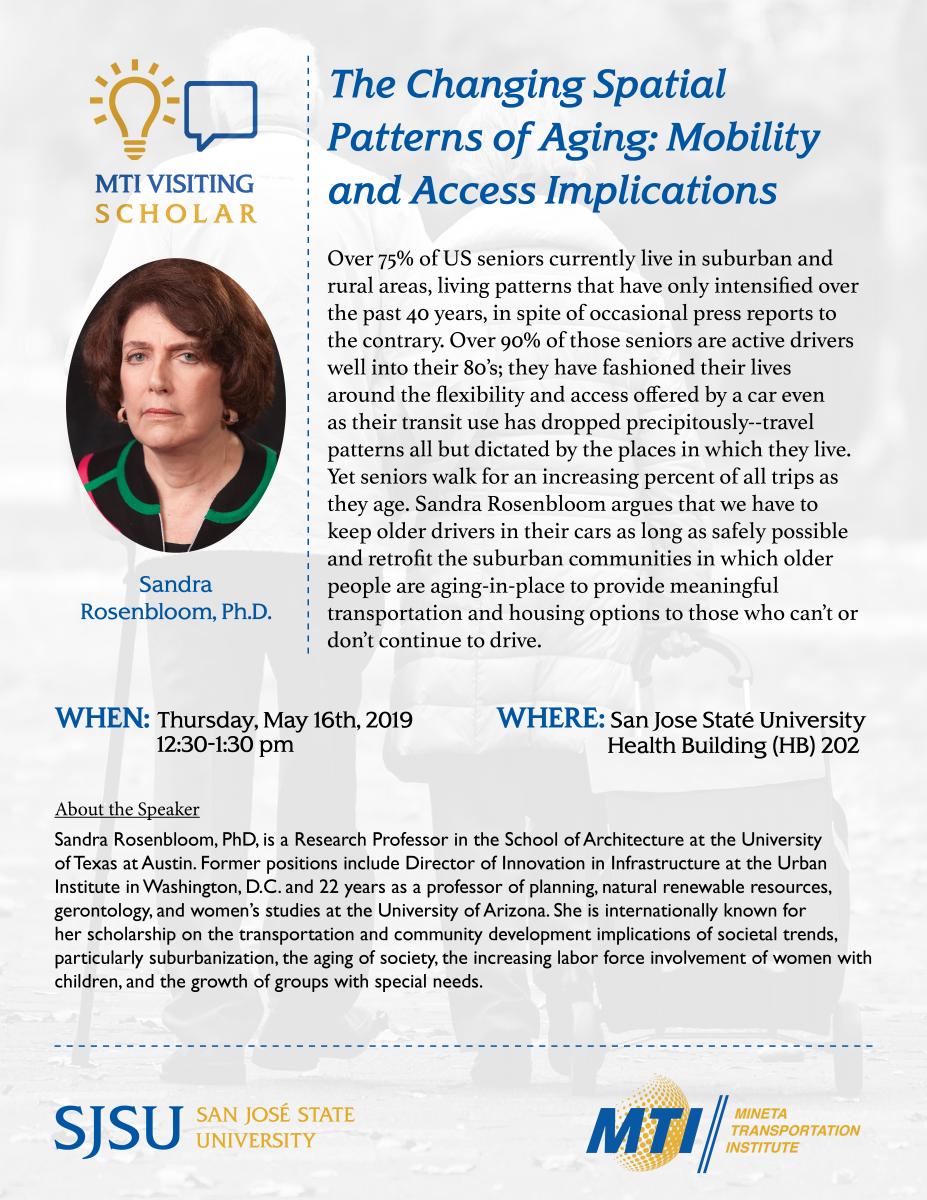 |
MTI Visiting Scholar Series presents: Dr. Sandra Rosenbloom in "Changing Spatial Patterns of Aging: Mobility and Access Implications" - San José, CA Over 75% of US seniors currently live in suburban and rural areas, living patterns that have only intensified over the past 40 years, in spite of occasional press reports to the contrary. Over 90% of those seniors are active drivers well into their 80’s; they have fashioned their lives around the flexibility and access offered by a car even as their transit use has dropped precipitously--travel patterns all but dictated by the places in which they live. Yet seniors walk for an increasing percent of all trips as they age. Sandra Rosenbloom argues that we have to keep older drivers in their cars as long as safely possible and retrofit the suburban communities in which older people are aging-in-place to provide meaningful transportation and housing options to those who can’t or don’t continue to drive. |
February 6, 2018 |
MTI Research Snaps Webinar: "Are Autonomous Vehicles Safe? Understanding What’s Already Here and What Needs to Happen" - Online This webinar, organized through the U.S. Department of Transportation, Intelligent Transportation Systems Joint Program Office covered recently concluded and ongoing projects related to safety and regulatory concerns for the expanding market of Autonomous Vehicles (AVs). The work presented was conducted within the past year at the RiSA2S Research Center of San José State University, a multi-disciplinary innovation center for the Risk and Safety Assessment of Autonomous Systems with funding support from the Mineta Transportation Institute. The activities of the lab are aimed at improving safety and better informing regulatory agencies in their recommendations for the certification process of autonomous systems. In particular, the seminar delved into three topics of current interest:
|
February 13, 2017 |
MTI Research Snaps Webinar: "Station-area Planning and Design for High-Speed Rail: Lessons for California and San Jose Diridon" - Online As both the scholarly literature and the experience on the ground indicate, good station-area planning is a very important prerequisite for the eventual successful operation of a high-speed rail (HSR) station; it can also trigger opportunities for economic development in the station area and the station-city. What is less clear, however, is what constitutes good station-area planning and how California station cities in general, and the Diridon HSR station in particular, can achieve it. Experiences from international examples of HSR stations can provide some valuable lessons. The webinar presenters drew from a detailed review of European case studies of HSR stations, a review of the relevant literature, and interviews with station area planners and designers, to explore issues surrounding HSR station and station-area planning. More specifically, the webinar addressed the following questions: 1) Which factors influence the impact of HSR on station-cities? 2) What are the elements of good station-area planning for HSR stations? 3) What are some common mistakes in designing and planning HSR stations? 4) What lessons do we learn from successful European HSR stations? 5) How do these lessons apply to San Jose Diridon station? Webinar Presenters: Anastasia Loukaitou-Sideris, PhD - MTI Research Affiliate, Associate Provost UCLA, Professor of Urban Planning, UCLA and Deike Peters, PhD - MTI Research Affiliate, Assistant Professor of Environmental Planning and Practice, Soka University of America. |
Pages
-
Contact Us
San José State University One Washington Square, San Jose, CA 95192 Phone: 408-924-7560 Email: mineta-institute@sjsu.edu





